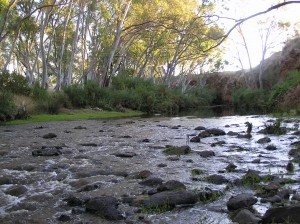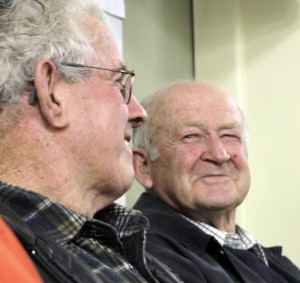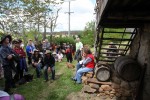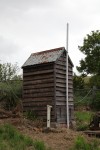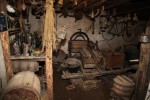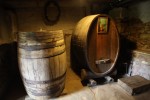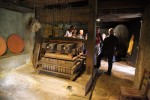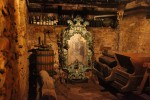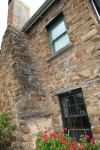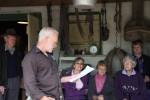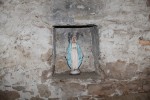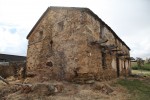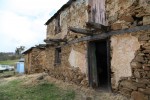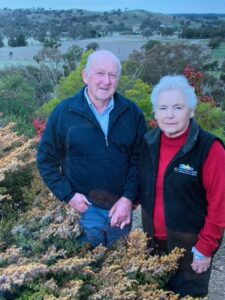
Yandoit Hall filled with locals in mid-July to pay tribute to Don and Joan Morrison at a thanksgiving afternoon tea. A number of tributes were shared acknowledging the many contributions both Don and Joan made to our community. Son, Robert who took over the family farm, gave a powerful tribute. Here’s the full version. An extract is is published in the September 2024 Chronicle.
I was asked to say a few words about mum and dad today, unfortunately I am recovering from the flu and regrettably haven’t been able to make it today. My two sisters Kay and Jeanette are still coming to terms with the loss of Mum and Dad and have respectfully declined to be present today. As for my brother Graeme has returned to New Zealand.
I believe Great marriages are no accident. The love and devotion Mum and Dad had for each other certainly stood the test of time .The fusion of these two souls over a life time I’m sure will last far beyond this world.
So how were this two people.
My father Don was borne to Dorothy and Edgar Morrison in 1931. He was a younger brother to Geoff and grew up here in Yandoit on the family farm as the 4th generation.
Leaving school dad not only worked on the farm but at times sort work picking grapes and working for a cropping farmer in the Mallee.
Dad used to say my Grandfather must have been a supreme optimist to think the fractured and undeveloped farm could ever support three families, so being the youngest he prepared to move away and start his life farming in the Mally. It was then his brother Geoff said he had decided to leave instead and sort a new life for himself and his wife Leslie else ware.
From then on Dad and my Grandfather set about clearing the land, repairing damage left behind by miners and installing an irrigation system that is still operating today.
My Mother Joan began her life west of Mt Tarrengower as her parents struggled to establish a farm prior to the building of the Cairn Curran Reservoir which consumed much of their property and is now known as Treloars bay. She was one of eight kids. Mum lost an older sister named Ester aged almost 5 to a snake bite and some years later her younger brother Joie under tragic circumstances.
As the eldest daughter of a second marriage she was given the job of helping raise her younger siblings as well as taking care of many of the house hold duties. Mum did not have an easy up bringing to say the least, it was in fact more like a real life Cinderella story. When Dad started going out with Mum he said to her “ I can’t offer you much, but I’ll promise you a better life than the one you’ve got “.
Like Dad, Mum held steadfast to her faith and for a while she also taught Sunday school.
After leaving school Mum’s artistic talent saw her gain work as a pattern maker for Thompson’s foundry in Castlemaine until she was married. It wasn’t uncommon for her ride her push bike from Maldon to Castlemaine and back for work.
Some of her drawings are still on display at the Maldon vintage Machinery museum.
The day they married was one of the happiest days of their life. Dad always said Mum was the most beautiful girl he had ever met and he couldn’t believe how lucky he was. He still carried a photo of her in his wallet up until the day he died.
Mum and Dads happily ever after began in Yandoit. Paying down debit and piecing the original farm back together.
Although life might have been challenging for them, it’s true to say they adored each other and loved their life together. Starting their own family brought them great joy with the arrival of twin girls followed by my brother and I.
The early 70’s saw the tragic loss of my little sister Judith who died shortly after birth, this lose never left mum and dad for the rest of their lives.
My parents embraced their young family. Some of my childhood memories include, a trip to the Royal Melbourne show, BBQ’s up the bush and the promise, if we were lucky might even get see a kangaroo! Then there were Bonfires for Guy fox night where the whole town would come around for cracker night. The occasional day trip to the beach and then there was the Maldon Easter procession. Mum loved to make costumes of Rabbits, mushrooms, and an emu using things like Chicken wire and paper Mashe. Mum would delight in dressing us up and sending us around in the parade.
The mid 70’s proved to be hard work milking around 60 cows and running up to 100 pigs. Mum was busy Raising four kids and Dad ran the farm with very little machinery and only basic infrastructure. Times were tough but about to get a lot worse when drought coincided with the Dairy industry collapse. Dad had no choice but to find work off farm to make ends meet. This was when he became a gardener in at what’s known now as the Castlemaine hospital.
Every week day he would get up, milk the cows, drive into Castlemaine to start work by 8:00 o’clock and work till 5:00. He would often spend his days walking up and down steep slopes mowing lawns and shifting sprinklers then return home to milk again. Sometimes he work into the night catching up on jobs or shifting irrigation pipes by torch light, before going to bed and doing it all over again the next day. One of the bosses in there said to him one day, ‘’why don’t you sell the farm and live an easier life’’ ? Dad paused then replied, “ Yes I could do that,…. but then I would think now what,….. I would probably want to buy a nice little farm somewhere with a creek running past it , I already have that !” Dad always knew the true value of what he had.
He eventually went from full time to 3 days a week and did this for 17 years . Not only did dads work load increase during this time but also mums as well. She would clean out pig sty’s, push wheel barrows of grain up hill to the dairy, clear rocks of paddocks, help cart in hay as well as keep house and raise us kids, attend mothers club meeting’s, school canteen, fire brigade ladies and played the organ at church.
It was at this time she also spent one day on the weekends scrubbing floors and doing laundry for her ageing mother and youngest brother while taking my sisters to piano lessons.
Although the days must have been incredibly long for dad, he also made time to be heavily involved in every community organization that was on offer.
His off farm work did however provide him with the opportunity to develop a close long standing working relationship with his work mates and enjoyed their company immensely. He also loved interacting with the elderly patients, bringing them flowers and taking an interest in them.
But for the first time in his life he had money in his hands. One of the first things dad bought was a Hoover floor scrubber and polisher for mum so she didn’t have get down on her hands and knees. Next was the first electric stove so time wasn’t wasted lighting the wood stove to cook his breakfast and thirdly a postie bike to bring the cows up for milking instead of walking around in the dark. We were a family and as kids we also did what we could to help out.
Eventually dad left his job and returned home for good where he could finally spend more time with mum and he and I could work alongside each other every day.
Dad’s job had given them the ability to eventually go on to build their retirement home and create a remarkable garden using the skills dad had acquired from work, coupled with mums passion for gardening.
It was a place they could immerse themselves in, bringing great pleasure to them both and now stands as a tribute to their hard work and self-sacrifice.
As a small child I always admired everything about my farther. I remember him tucking us tightly into bed and telling us stories. I remember him holding me tightly as we sat around the open fire at night. I remember the times he took me on the grey fergie tractor ploughing, raking hay or feeding out. It didn’t seem to matter, he was always doing something exiting and he couldn’t keep me away.
Over the years we spent so much time together and shared so much in common. We could talk about anything and everything and no subject was of limits. We just enjoyed each other’s company and the love of farming. He lifted me up when I was down, he gave me strength and encouragement when I need it, he was everything a farther could be and more, he was indeed the very wind beneath my wings.
All I ever wanted was to try and follow closely in my father’s footsteps – I wanted the life and love that Mum and Dad had lived.
The family they had raised meant they had a one daughter trained as a nurse to watch over them another who could step in as their carer, a son who would look after wood cutting and house maintenance when he could and the youngest son to honor the farming legacy they worked so hard for giving Dad a welcome distraction after mums passing .
He often said his two Great loves in his life were Mum and the farm.
Growing up as kids we had everything we needed, parents who loved us and the space and opportunity to grow into whoever we wanted to be. How grateful we are.
They didn’t live perfect lives, they lived Exemplary lives.
Rest in peace, Mum and Dad.
Married 67 years
Geographic Names Victoria has gazetted the renaming of Jim Crow Creek to Larni Barramal Yaluk in the Victoria Government Gazette.
Dja Dja Wurrung Group CEO Rodney Carter reiterated the importance of the name change. “This creek has an identity and has a spirit. We are at last affording it the respect it deserves by giving back its name, to now say its name is speaking to Country in the most beautiful way.”
Hepburn Shire Mayor Brian Hood said: “The term Jim Crow has its origins in racial segregation and anti-black racism and is therefore unacceptable. Larni Barramal Yaluk, which means home or habitat of the Emu Creek, reconnects the landscape with Dja Dja Wurrung culture and language,” Mount Alexander Shire Mayor Rosie Annea said:.“Changing the name is important for many reasons – it recognises and honours the traditional owners of our region, is inclusive, and connects us to our Aboriginal heritage. It also reinstates Dja Dja Wurrung language into the landscape.”
‘Yaluk’ also ‘Yallock’ means a creek, and appears to be widespread in nearby aboriginal languages. One will recognise names like ‘Woori Yallock’, ‘Natte Yallock’ and ‘Mordialloc’. Our first nations people were blessed: not having a written language (at least in the Western sense) they were never burdened by ‘spelling’! Romanisation of Aboriginal languages can only ever be a lame approximation, always a bit arbitrary.
How did the Creek ever have the name ‘Jim Crow’? …
Not local history, but I thought I should share it as it gives more than a glimpse of shearing in the early days. “Duke” Tritton began shearing, with blades, in 1905. Duke sings his song, written in 1905 (but obviously updated, as it mentions ‘Vanguards’ and ‘Holdens’, originally ‘buggies’ and ‘sulkies’, from transcriptions): ‘Shearing in a Bar’…
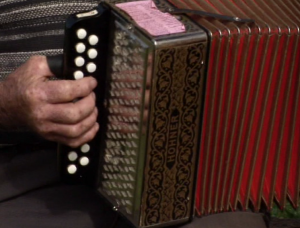 6pm, Saturday April 7th at the Yandoit Hall,
6pm, Saturday April 7th at the Yandoit Hall,
BYO barbecue from 6pm
This unique event will explore the long history of music and dance in our area.
- Multimedia presentation and display
- Panel discussion on the musical history of Yandoit and district
- Demonstration old-time dances
- Dance participation for all to join in
- Live music from Maurie Gervasoni, Greg and Helen O’Leary, Ian White, Peter Sullivan, Natasha Mullings and John Ross.
“Mr McKinnon, who first saw the finished work in October, described the painting as “pretty realistic”, and said he hoped it would come away with an award.
While part of the hut has begun to fall down and Mr McKinnon has been restricted to the front rooms of the quaint property, the historic property which boasts a large open fire still provides the regular meeting place for Mr McKinnon’s mates to come over for a cuppa.
And despite the lack of power, Mr McKinnon says he couldn’t imagine living anywhere else.”
(Advocate, Brendan Wrigley)
http://www.hepburnadvocate.com.au/story/4724944/immortalised-in-paint/
An earlier article on Duncan McKinnon, of Old Nuggety Farm, Yandoit
(from the Advocate).
http://www.hepburnadvocate.com.au/story/2855130/a-simple-but-good-life-at-old-nuggetty/
HMS Terror sank during a disastrous expedition led by British explorer Sir John Franklin, after whom Mount Franklin is named. Franklin was attempting to chart the North-West Passage, from the Atlantic to the Pacific via the Canadian Arctic.
”The long-lost ship of British polar explorer Sir John Franklin, HMS Terror, has been found in pristine condition at the bottom of an Arctic bay, researchers have said, in a discovery that challenges the accepted history behind one of polar exploration’s deepest mysteries.”
And here’s a song to go with it…
In 2013 I came across a very interesting grave in the Newstead Cemetery. The inscription on the grave said that Henry Mertin and his wife Christina were buried there. It was not the surname Mertin that attracted my attention, but the first names, Henry and Christina, because I knew from my family history work that there was, in my family tree, an interesting couple with those names who had lived in Yandoit in the mid-1800’s. The surname though, was wrong . The couple in my family tree were Henry and Christina Martin, not Mertin. So the name was wrong, but close enough for me to follow up to find if this couple was in fact the one I was interested in.
But first, why am I interested in the history of the Newstead/Yandoit area at all? Very briefly, my great grandfather and great grandmother came separately to Australia for the gold rush. They met, married and settled in Yandoit in the 1850’s. They ran a hotel and store in Yandoit and lived there for the rest of their lives. Some of their descendants lived there until the 1940’s. My great grandfather came to Australia from America, and my great grandmother came from Germany.
I have always been interested in the lives of these ancestors of mine, and particularly in my great grandmother, Anna Elisabetha Dern. Although my father knew a lot about our family history, all he could tell us about Anna Elisabetha was that she came from Germany, at the age of 16, apparently accompanied only by another girl of about the same age.
Over many years of research, I have found a lot more information about Anna Elisabetha, why she came to Australia and who came with her. In fact, many German immigrants came here in the mid 1850’s to escape very hard times in Germany, and Anna Elisabetha was actually accompanied in the sailing ship that brought her here by many other Germans from the same village including some close relatives. These included two brothers and a number of first cousins. Several of the cousins had the first name of Christina, a very popular name for girls in Germany at the time.
That’s enough background. What follows is an account of what happened to one of those cousins, Christina Dern. Continue reading
”Don Morrison is still milking cows at the age of 83 alongside his son Robert and twenty-three year old grandson, Nick”.
You’d think they would let him retire!
Good read…
http://www.abc.net.au/local/photos/2015/09/21/4316522.htm?xml=4316522-mediarss.xml&1442799173283
I am informed of the sad passing of Peter Ellis following a short battle with pancreatic cancer. Peter Nicalous Ellis of Bendigo (b 1946) has been an avid collector and instructor of traditional and old time social dances and the relevant music  in Australia since late 1970s. He has presented numerous workshops in both areas in several states and at many folk festivals including the National, Maldon, and Port Fairy.
in Australia since late 1970s. He has presented numerous workshops in both areas in several states and at many folk festivals including the National, Maldon, and Port Fairy.
Also a historian on the early social dance and music, he regularly provided articles and photographic material for Trad & Now magazine.
He was a member of the Wedderburn Oldtimers Orchestra (since 1979, led his own Emu Creek Bush Band since 1983, founded the Bush Dance & Music Club of Bendigo and through the auspices of both, who work hand in glove together, has produced numerous recordings.
Much of his knowledge has come from a close acquaintance with the late Harry McQueen of Castlemaine.
Publications include the Collector’s Choice series in 3 Volumes, Music Makes Me Smile (music and dances of the Nariel Valley), The Waltz, the Polka and all kinds of Dance Music and The Merry Country Dance. He has also made extensive collections for the National Library of Australia and his section on dance is said to be the most extensive.
Peter was a Laboratory Technician (Chemistry) and worked at LaTrobe University Bendigo and its former Technical College and CAE as well as local Secondary Colleges. He retired in 2012 from Bendigo Senior Secondary College.
Peter was known in our area through his association with the old-time dances at the Yandoit Hall.
He made a difference and will be sorely missed.
(Text, Billy Folkus; photo, Bendigo Advertiser).
With winter rains, the creek is flowing. Out walking last week there was no stepping over stones to get to the other side. The creek was alive, coursing its well-worn channel, enticed as ever by the laws of gravity towards the Loddon, to join the Murray, to empty into the ocean. I sat and listened. What is it about the sound of moving, bubbling water that so compels, that draws us in? At the creek’s edge there is only the sound of pure music, of water tumbling, cascading between stones, earth, roots, branches. The song of water touching everything in its path. A Psalm reverberating between the banks.
I have entered a sacred world. Everything is animate. I am mesmerised. A blue superb wren joins the song. Ears alert to the chatter of buff-rumped thornbills darting in and out of callistemon, once again thriving along the creek. My eyes dip beneath the water’s surface, watch the lively dance of refracted sunlight and shadow on stones. Out of their warm casings come my bare feet, slipping into the cold wet rush, testing for steady footholds. From inside the creek bed I survey the landscape: branches of woolly tea-tree, stands of phragmites further downstream, the vertical camber of the western bank, the shade of river reds, a paddock of kangaroo and wallaby grass, a stone wall skirting the hills, in the distance along the fence line the gnarled rough trunk of eucalyptus melliodora, yellow box, statuesque, those same branches outstretched for who knows how many years, clusters of delicate leaves bunched together like heads of broccoli.
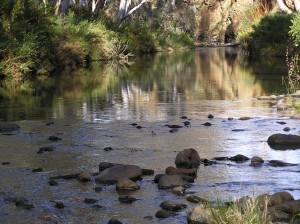 I try to imagine what the creek has witnessed, this ancient meandering gathering place, this spring-fed life source, this bountiful commons for flora, fauna and humans alike. Like a goldminer prospecting, I am besieged with possibilities in the form of questions: what companions has the creek nourished and what visitors hosted? What passages has it enabled and what crossings forded? What flows has the creek carried and what landscapes carved? What depths has it reached? What minerals flushed out? Who’s thirsts have been quenched? What images reflected? What losses has the creek borne and what revivals has it welcomed?
I try to imagine what the creek has witnessed, this ancient meandering gathering place, this spring-fed life source, this bountiful commons for flora, fauna and humans alike. Like a goldminer prospecting, I am besieged with possibilities in the form of questions: what companions has the creek nourished and what visitors hosted? What passages has it enabled and what crossings forded? What flows has the creek carried and what landscapes carved? What depths has it reached? What minerals flushed out? Who’s thirsts have been quenched? What images reflected? What losses has the creek borne and what revivals has it welcomed?
Memory keepers Don Morrison, Fleur Smith (nee Staley) and Maurie Gervasoni.
In the beginning-it’s raining stories and laughter
At our first session in August 2013 the hall overflowed with people while voices of story tellers competed with downpours on the roof. We opened with intimate details of creating home and garden, described by Margaret Morrison in an 1856 letter encouraging her Scottish sister to join them in ‘this beautiful valley’ of Yandoit, ‘about half a mile long and not quite so broad’. Listening to Kay O’Connor reading her great, great, great, great grandmother’s letter we saw the creek through a new settler’s eyes ‘running down one side of the valley with almost every description of flowers, beautiful shrubs, and good large trees in bloom growing on its banks’. We learnt of land ploughed to sow oats and wheat and were invited to imagine this ‘mixture of all nations’, this locale which inspired the new minister to remark: ‘I never knew there was such a pretty place’. We appreciated skills passed down through the generations: ‘what a baker I have become’ writes Margaret, ‘making bread, baps, scones and fancy cakes’. Her descendant Kay has a reputation for making the best scones in Yandoit and hers were among many batches generously baked for our ‘words in winter’ history in story café.
I am interested in the route taken by coaches between Castlemaine and Ballarat and the stops along the way.
I believe they came through Guildford, down Yandoit – Guildford Rd (Limestone Rd) and stopped for a change of horses at Yandoit before travelling on to Ballarat.
From a search of the internet (http://www.niederweisel.com/hauserm41.html) I have found that Georg Fleischer whose home was in Camp St Yandoit, extended his home to provide lodgings for travellers and Cobb & Co horses, in the 1860s.
Is Camp St now either High Street or Yandoit Creek Rd or some other location within Yandoit?
Did the coaches leave Yandoit via continuation of High St or did they go up Yandoit Creek Rd, possibly both over time
Would appreciate any information or guidance towards other information
regards
Mal
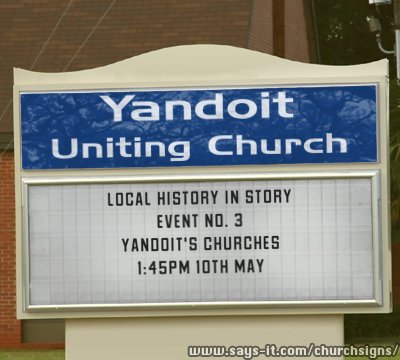 Churches and settlement of Yandoit, Franklinford and Clydesdale
Churches and settlement of Yandoit, Franklinford and Clydesdale
When: SATURDAY MAY 10th, 1.45pm for 2pm start
Where: meet at the YANDOIT UNITING CHURCH
Afternoon tea at 4.00 followed by optional visit to several local churches between 4.30 to 5.30pm.
See the May 2014 Chronicle for details
 Produced by Alfred Selwyn, Mineral Surveyor for Victoria, in 1853, this map notes the vegetation types and distribution not long after white settlement.
Produced by Alfred Selwyn, Mineral Surveyor for Victoria, in 1853, this map notes the vegetation types and distribution not long after white settlement.
See also:
http://www.fobif.org.au/2013/03/the-selwyn-map-quiet-calm-terrible-disturbing/
Click here to download the full-size map:
large.selwyn_map2-3.pdf








